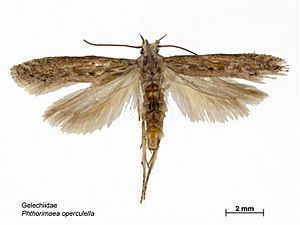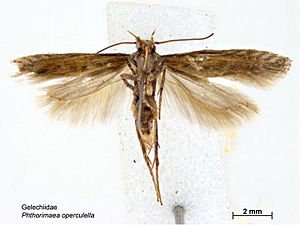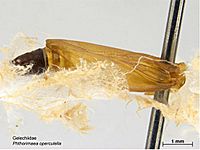Potato tuber moth facts for kids
Quick facts for kids Potato tuber moth |
|
|---|---|
 |
|
| Dorsal view | |
 |
|
| Ventral view | |
| Scientific classification | |
| Kingdom: | |
| Phylum: | |
| Class: | |
| Order: | |
| Family: |
Gelechiidae
|
| Subfamily: |
Gelechiinae
|
| Tribe: |
Gnorimoschemini
|
| Genus: |
Phthorimaea
|
| Species: |
P. operculella
|
| Binomial name | |
| Phthorimaea operculella (Zeller, 1873)
|
|
| Synonyms | |
|
|
The potato tuber moth, also called Phthorimaea operculella or tobacco splitworm, is a type of moth. It belongs to the family Gelechiidae. This moth mostly eats plants from the Solanaceae family. It is especially known for being a big problem for potato farms.
Farmers use different methods to stop these moths. They use special sprays (insecticides), helpful insects (parasites), and water sprinklers. These methods help protect their crops from the potato tuber moth. Female moths have special sensors to find host plants. They can lay their eggs even if they are just near a plant.
Contents
What Does the Potato Tuber Moth Look Like?
The potato tuber moth is about 10mm long. Its wings can spread up to 12mm wide. Adult moths have a thin, light brown body. Their wings are grayish-brown with small dark spots. Both sets of wings have edges that look a bit frayed. Female moths have a black "X" shape on their front wings when they are closed. This helps tell them apart from males.
Where Do Potato Tuber Moths Live?
P. operculella can be found all over the world. They prefer warm places like subtropical, tropical, and Mediterranean climates. In the United States, they have been seen in at least 25 states. They are common along the Atlantic and Pacific coasts.
You can also find these moths in Africa, Asia, Europe, South America, and Oceania. In total, they have been reported in over 90 countries.
Potato Tuber Moth Habitat
Potato tuber moths usually live near potato plants. They also live close to other plants in the Solanaceae family. Temperature is very important for these moths to survive and grow. This is why they are usually found in warmer, tropical, and subtropical areas.
What Do Potato Tuber Moths Eat?
Potato tuber moth larvae (young moths) eat parts of potato plants. They feed on the tubers (the potatoes themselves), roots, and leaves. On leaves, they act as leafminers, eating inside the leaf.
Larvae can only find potato tubers if they are exposed. The tubers must be within 1 cm of the soil surface. There is no proof that new larvae dig deep to find tubers using the roots. On leaves, the larvae mostly eat the mesophyll. This leaves brown or white spots on the leaves, called blotch mines.
The potato tuber moth also eats other plants in the Solanaceae family. These include tobacco plants (Nicotiana tabacum), eggplants (Solanum melongena), tomatoes (Lycopersicon esculentum), and bell peppers (Capsicum annuum).
Potato Tuber Moth Reproduction
Laying Eggs (Oviposition)
The female potato tuber moth has a special part called an ovipositor. It is about 1.5mm long and 0.3mm wide. It has tiny hairs on its sides and tip. These hairs help the moth find good places to lay eggs.
Female moths do not need to be on a host plant to lay eggs. However, they lay the most eggs when they are near a preferred host plant. They look for small cracks or dips on surfaces. These spots are usually 0.2-0.5 mm wide. They prefer surfaces that are hairy or rough over smooth ones.
Female moths also strongly prefer dry places for their eggs. Studies show that they lay fewer eggs on wet surfaces. They also like to lay eggs in shady spots, not bright light.
Experiments show that female moths lay more eggs over their lifetime than they have when they first emerge. This means eggs continue to develop as the adult moth lives. The number of eggs laid depends on how much food and water the adult moth finds.
Choosing a Host Plant
Adult female moths prefer to lay eggs on plants from the Solanaceae family. Their ovipositor has sensors that detect chemicals from plants. These sensors help the moth choose the best plants. A study by P. G. Fenemore found that potato tuber moths are attracted to an amino acid in potatoes called L-glutamic acid. This chemical helps them decide where to lay their eggs.
Potato Tuber Moth Life Cycle
Egg Stage
A female P. operculella can lay over 200 eggs in her lifetime. This number depends on the environment. The eggs are usually oval-shaped and smooth. They are pearly white to yellowish in color.
Eggs typically hatch in about five days. They can be laid on the soil near a host plant. More often, they are laid next to a leaf vein, between a bud and a stem, or under the stem.
Larva Stage
Potato tuber moth larvae are usually 12-15mm long. They are white or yellow with a brown head. As a larva grows, its color changes to pink or green. The body has small black spots and bristles on each part.
Larvae usually feed on their host plant for up to two weeks. Then they get ready to become pupae. To decide if it wants to mine a plant, a larva walks around the leaves for 5–15 minutes. It leaves a silk thread as it moves. It bites the leaf a few times. Once it chooses a spot, it builds a silk roof. Then it starts to dig down, pushing leaf pieces aside.
On plants they don't like, larvae bite less and leave less silk. They also walk faster on non-host plants. If they reach the edge of a leaf they don't like, they will leave the plant instead of turning around.
Pupa Stage
The pupae of P. operculella are thin and about 0.5 inches long. They are usually white. It takes 10–30 days for them to develop. This time depends on the weather and other conditions.
Adult Stage
Adult potato tuber moths are active at night. They usually become active 1–2 hours after sunset. For a long time, people thought they were not good at flying. But a study in 1985 showed they can fly for over 5 hours and 10 kilometers without stopping in a lab.
P. operculella usually live for 1–2 weeks. Mating starts about 24 hours after they emerge. Most eggs are laid in the first week of the female's life. Females lay the most eggs between 2–5 days after they emerge. After day 7, the number of eggs laid drops a lot.
What Are the Potato Tuber Moth's Enemies?
Parasites
A larval parasite called Apanteles subandinus was brought in to help control potato tuber moth outbreaks. This parasite kills the moth when it is almost done with its larva stage. It has been successful in controlling moths that infest leaves.
In South Africa, a spider called Selenops radiatus also helps control these moths. The wasp Diadegma mollipla, also found in South Africa, is another parasite that attacks the moth's larvae.
How Potato Tuber Moths Interact with Humans
Pests of Crops
The larvae of potato tuber moths can cause a lot of damage. They harm potato, tobacco, and tomato plants. The larvae eat the leaves, and then they eat the tubers (potatoes) too. This stops the plants from growing well. Sometimes, the larvae eat through the potatoes, making them impossible to sell.
Insecticides are often used to kill these larvae. However, they only work on larvae that are on the leaves. They do not work well against larvae inside the tubers. Larval parasites, like Apanteles subandinus, have also helped control leaf infestations. But they don't have a big effect on tubers.
The best way to stop larvae from eating the tubers is with sprinkler irrigation. This makes the ground wet, which discourages female moths from laying their eggs there.



